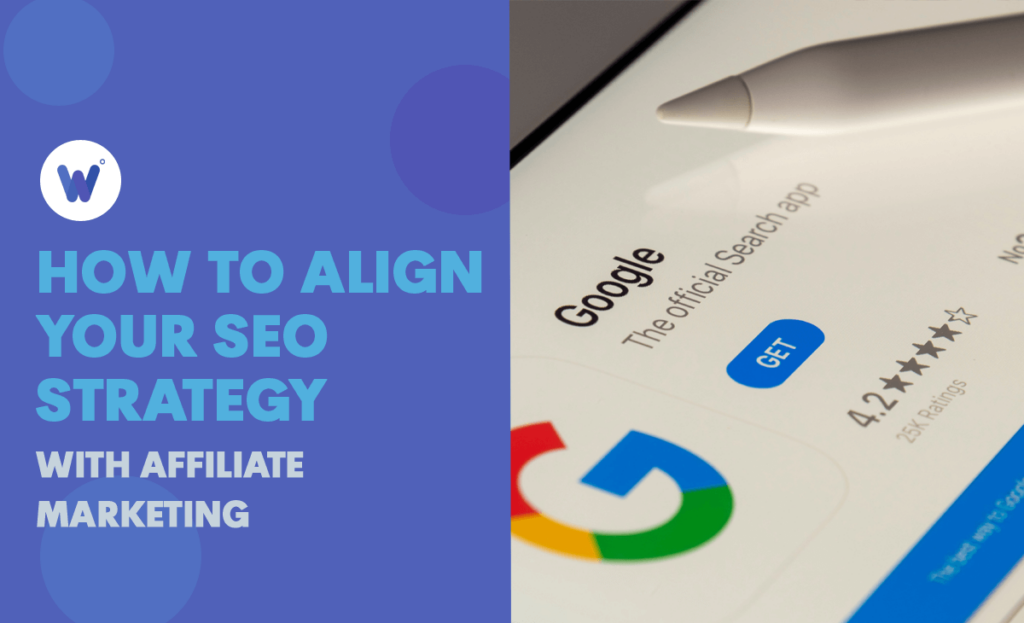
Affiliate marketing isn’t new.
But even though it’s a popular tactic, there’s still room for improvement when it comes to aligning your business’ affiliate marketing with other parts of your marketing strategy.
Take search engine optimization (SEO), for example.
Feeding SEO strategy into your affiliate marketing can boost your results. It helps you reach your audience with the right message, at the right time.
But knowing how to align these practices can be tricky, especially if you’re not 100% sure how the two relate to each other in the first place.
In this article, we’ve covered why SEO affiliate marketing is important and outlined some practical ways you can combine the two.
Effortlessly export your Google Docs to WordPress with just 1-click.
Get Started Today
First, let’s clarify what affiliate marketing is.
Affiliate marketing is when businesses and content creators earn a commission per sale by promoting a product or service from another business.
Promotions can take place in guest posts on blogs (by adding links to the product or service) or via social media posts. On social media, the affiliate will make a post about a product or service.
For our more visual learners, here’s how affiliate marketing works:

For the purpose of SEO affiliate marketing, we’ll focus on promotions that take place on web pages.
SEO affiliate marketing involves optimizing your affiliate pages. The aim is to make them discoverable online when people search on Google (or other search engine) for products or services that you sell.
For example, let’s say you partner with an affiliate to promote your kitchenware products. To boost traffic and views to this page, you want to make sure that the page is seen by as many people as possible.
This is where SEO steps in.
Working with the affiliate partner, you’ll make sure that the page is optimized for SEO. This involves doing the following:
By optimizing the page, Google is more likely to rank it higher. This means that consumers searching for relevant phrases are more likely to come across the page.
It’s a win-win for both you and your affiliate partner — more people will visit their site and you have a higher chance of getting more clicks on your affiliate link.
Now that you have a more solid understanding of how SEO and affiliate marketing can work together, here are some best practices to follow to make the most of it.
Partnering with the right affiliates can impact the amount of traffic you get. If you’re partnering with the wrong people, no matter how much search optimization you do, chances are you won’t get found by the right people.
Here’s what you need to do to make sure you’re partnering with the right affiliates.
Find companies/bloggers in your niche:
If you want to reach the right audience, you need to partner with affiliates that have a similar following.
Take a look at Adam Enfroy, for example. His site targets entrepreneurs looking to start their own blogging business.
His affiliate links are relevant to this audience.
In this article, he reviews the best screen sharing software — tools which are helpful for a business owner working with an offshore development team.
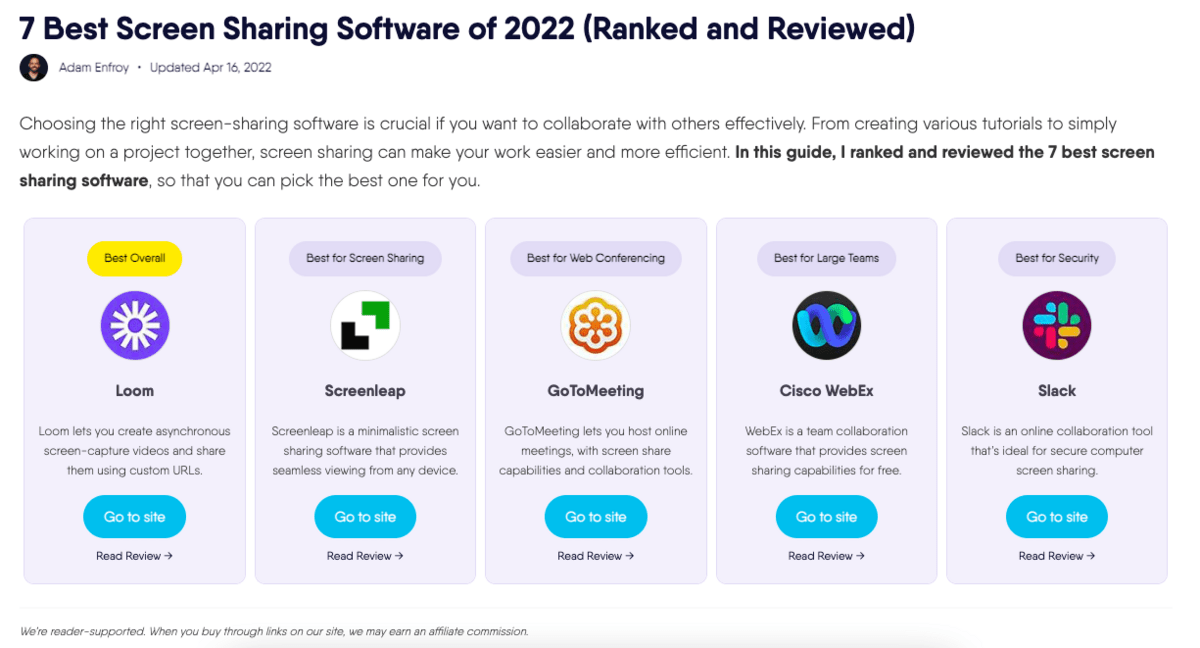
All of these are affiliate links, but they’re relevant. His target audience is similar to the target audience of these companies, so it makes sense for them to partner with him.
Consider their brand perception:
When you use affiliate marketing, you’re associating yourself with your other brands. This can influence the way prospective customers perceive your brand, so it’s something you need to consider.
Spend some time reviewing the brands in detail before you decide to partner. Look at their website, their social media, and their following, and ask yourself the following questions:
All this information will help you decide if a business or affiliate is a good match for your brand.
Review traffic potential:
When deciding whether to partner with an affiliate, you need to consider how much traffic their website currently gets.
Think about a site that isn’t attracting a lot of traffic. They’ll have fewer people visiting their site, meaning you might not get the results you want. On the other hand, if they’re seeing a lot of traffic and engagement for the right keywords and phrases, they could be a better fit.
So how exactly do you know how their traffic is performing?
One way is with a user-friendly tool like Neil Patel’s Website Traffic Checker — simply enter the URL of an affiliate you want to partner with and click the ‘Check the Traffic’ button.
Let’s go back to our previous example and say that you offer kitchenware products. Here’s a traffic overview that the tool shows for a blog on Asian recipes:
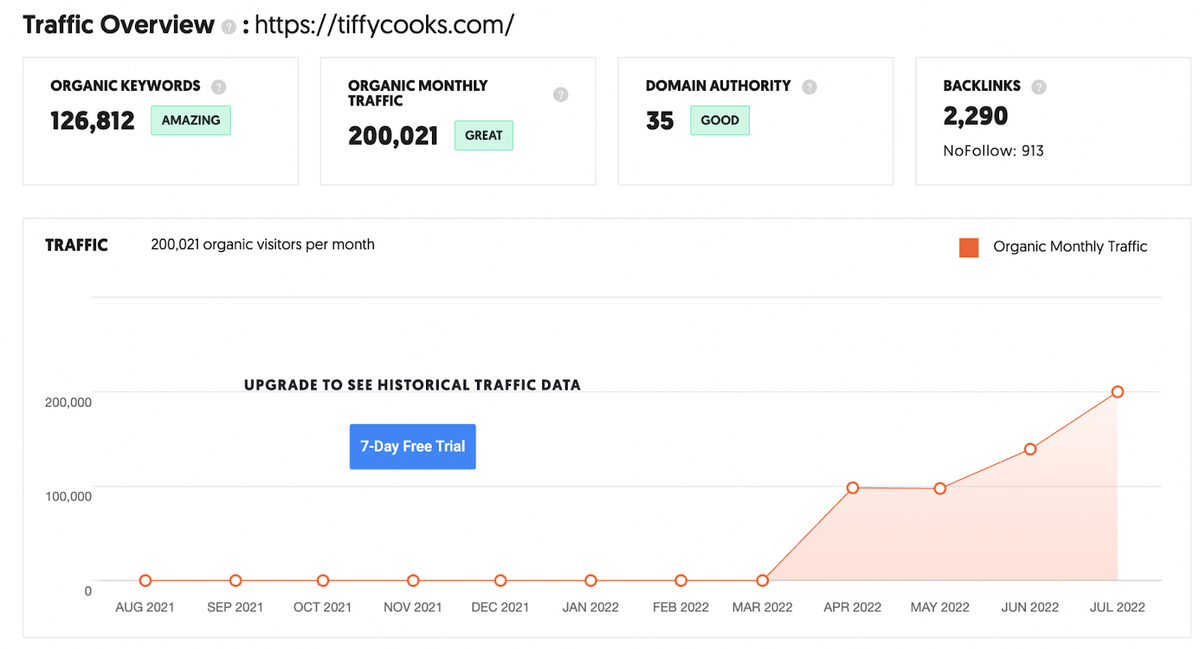
Here we see that the site gets over 200,000 visits a month. This particular affiliate would definitely be worth reaching out to!
Be sure to use more than one tool to analyze website traffic. That way, you can fill in any gaps and get the most accurate picture of the web traffic stats.
Whichever platform you decide to use, here’s the information you should be looking for:
From here, you can determine if the affiliate is a good fit.
According to a survey from Semrush, 55% of respondents said improving content quality made their content strategy successful. Why? For two reasons:
When it comes to your affiliate program, you need your content to be thorough, detailed, and unique.
Here are some tips for delivering quality content.
Understand, and align with, search intent:
The first step to creating quality content for your audience is to know what they want to see. Understanding search intent or the “why” behind is a search is a good way to do exactly that.
For example, let’s say your affiliate content is targeting the keyphrase “accounting services near me.” You need to know exactly what type of content the consumers want to see when they search for this phrase. If you don’t, you risk creating content that won’t keep them on the page. And if they don’t stay on the page, they won’t click your link.
If you’re new to identifying search intent, don’t worry. The easiest way to determine search intent is to simply search for a keyword and look at the results. This will tell you what people are expecting to see when they search for certain phrases.
Here’s an example of the search results when searching for “streaming music platforms”:
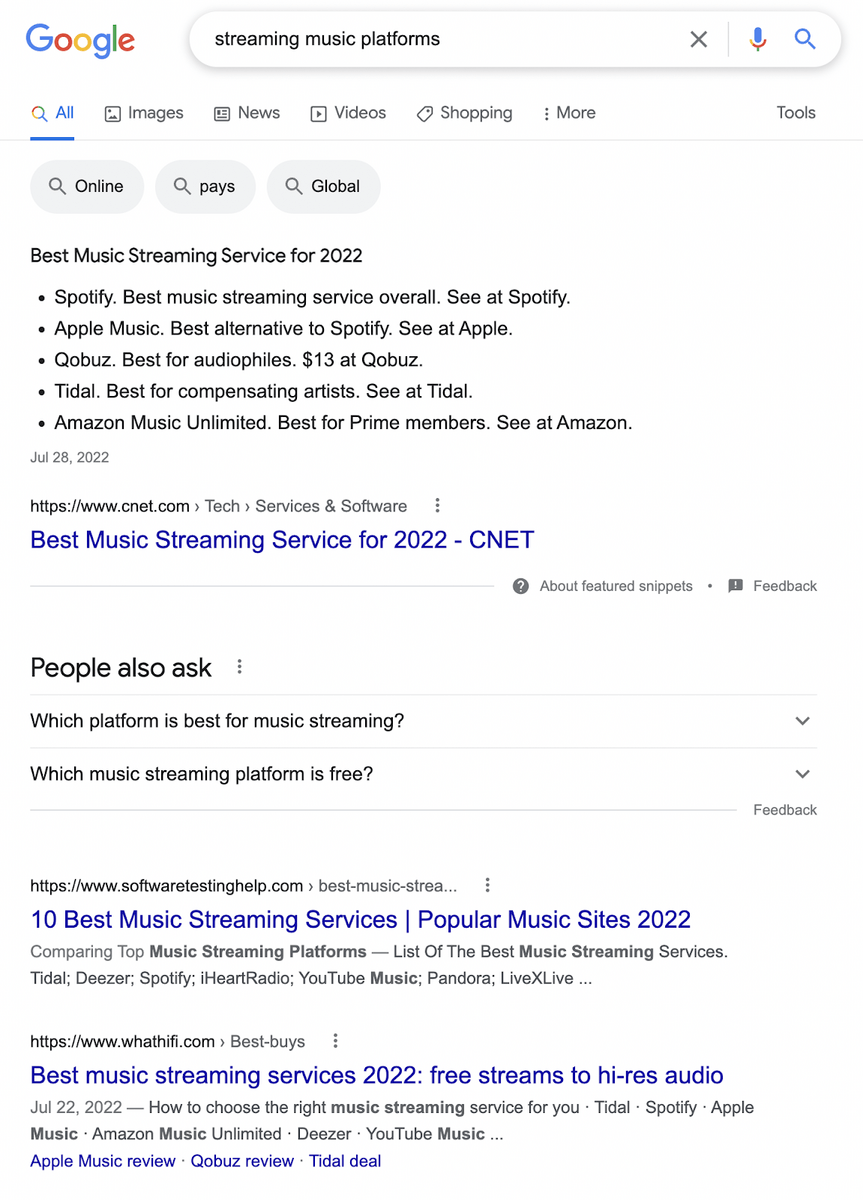
Google is ranking informational articles that provide an in-depth review of the most popular music streaming platforms. If you want to rank for this term, you’ll need to match the search intent here and follow a similar structure.
There are also tools you can use to find out more about search intent, including Semrush, Yoast, and cognitiveSEO.
Create content that’s easy to understand and well-structured:
Quality content isn’t just about writing long and detailed articles. It also needs to be well-structured, easy to follow, and simple to read.
Put yourself in the shoes of a consumer. Imagine you’re trying to find out how to create an SEO strategy. You Google “SEO strategy for beginners” and click the first article.
You’d imagine that the article would be pretty easy to follow, right?
So what would happen if the article were too complex? If it was full of jargon and overly complex sentences?
Chances are, you wouldn’t stick around.
To make sure your audience actually reads your affiliate content (and stays on the page), you need to be clear and concise.
For more advice, take a look at our content marketing tips.
Provide actionable advice:
The last thing you want is for a reader to walk away from your article not knowing what to do next.
Your affiliate content should offer practical advice for your readers. They can read your content, understand what they need to do, and put their newfound skills into practice.
But how can you make sure your content is actionable?
Familiarizing yourself with the Actionable Content Pyramid is a good starting point.
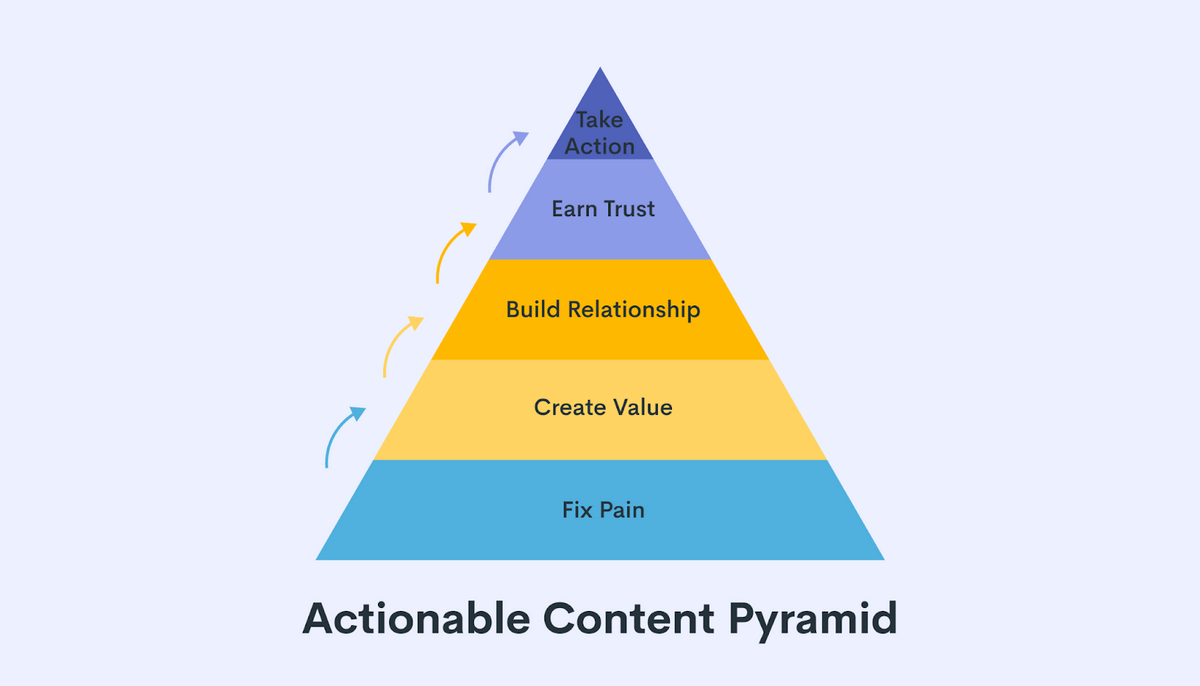
Using the steps in the pyramid, you can create content that shows users how to fix their problems. It builds trust, loyalty, and shows potential customers that you’re an industry expert.
Take a look at our blog post on how to make your content actionable and learn how to add more value to your content.
As you know, affiliate links are paid links because there’s a commission involved. For search engines like Google, paid links aren’t considered natural authority. In other words, these links shouldn’t contribute to the overall rankings of the site.
Search engines crack down on affiliate sites with too many paid links. As a result, you need to remove those links from calculating link authority. This means Google will ignore the link when crawling the page.
But how exactly do you create nofollow links?
It depends on the web platform you’re using, but here’s how to manually create nofollow links:
Here’s the HTML code for an example nofollow link:
<a href=”examplesite.com” rel=”nofollow”>This is a nofollow link</a>
Notice the “nofollow” HTML tag? That tells Google to ignore the link and not pass any authority to it.
Some web platforms allow you to automatically add a nofollow link when you insert a URL. That way, you won’t have to manually amend it.
Here’s how to do it in WordPress:
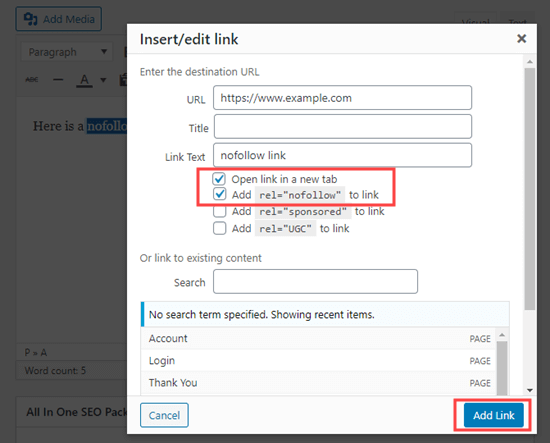
It’s a pretty straightforward process. The system takes care of it for you, so you don’t have to worry about site rankings taking a hit when the content goes live.
Google sometimes identifies nofollow links automatically. But to be on the safe side and avoid penalties, it’s best to use the nofollow tag.
Merging your SEO and affiliate marketing activity makes sense. It helps you create solid, quality content that’ll reach a wide and relevant audience. And isn’t that pretty much the point of affiliate marketing in the first place?
Use the tips outlined here as your starting point and start aligning your affiliate marketing with your SEO efforts. You won’t regret it.
When it comes to creating and publishing affiliate content, take a look at Wordable. Using our software, you can streamline the entire publication process. How? By uploading content from Google Docs to your website in just one click. Try it for free today!